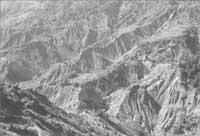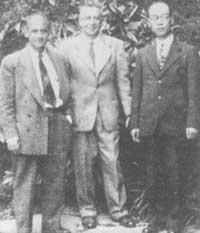Age of the Earth
1989/09/01 Irusta, Lourdes Iturria: Elhuyar aldizkaria
Today geologists measure time in thousands or millions of years and that does not surprise us.
However, only three centuries ago, geologists, considering the manifestations that appear in the biblical, believed that the Earth was born in 4,000 years before Christ.
Initial studies

Buffon was the 18th. In the eighteenth century he studied scientifically the age of the Earth.
To calculate the age of the Earth, he knew that our planet is a melting mass that cools and that by choosing a proper cooling speed, he could calculate the age of the Earth. Therefore, he declared that the Earth was 75,000 years old.
Buffon's work is simple, but it was the first research that questioned the age of the Earth that can be obtained from Genesis.
It was a huge revolution in society back then and provoked numerous debates. To solve this problem, John Philips conducted another type of research. In the 20th century. Consider that the best way to measure geological time would be to measure the thickness of each stratum.
Measuring the thickness of each stratum and knowing the average sedimentation rate, he could calculate the age of the Earth.
He could not know the variation of the sedimentation rate with respect to time, so he was forced to recognize that the sedimentation rate has been constant when performing the calculations, despite having put this hypothesis.
Estimating that the age of the earth's surface was 96 million years.
Other scientists worked on the same problem in the 19th century. At the end of the 20th century.
One of them is John Joly.
According to John Joly, the amount of sodium the seas have can be known as the Earth. At first the sea had no salt and the rivers are the ones that have gradually moved the salt to the sea. He knew that this process occurred at a uniform speed.
He estimated that the Earth age ranged from 90 to 99 million years.
Scientist Lord Kelvin also reached this result. In the 20th century.
Lord Kelvin calculated the age of the Earth from the idea of Buffon. For Kelvin, the age of Earth can be obtained from the study of the internal temperature of our planet. The Earth was initially a fusion mass. The molten stones cool and suffer a volume contraction.
Therefore, the stones that were on the Earth's surface cooled and their density increased due to volumetric contraction, reaching the bottom.
This phenomenon triggered convection currents until the total solidification of the planet.
He estimated that the age of the Earth was 98 million years.
However, Kelvin amended his law and the XIX. At the end of the 20th century, the age of the Earth was 24 million years.
Radioactive studies

Although Henry Becquerel's works on radioactivity were published in 1896, it was not until 1903 (that is, until Pierre Curie investigated that radio salts emitted permanent heat) that radioactivity could have an important role in geological studies.
The time it takes for a radioactive element to break down is accurate and has nothing to do with physical-chemical conditions. Therefore, when a number of radioactive elements are generated in the universe, it begins to decompose.
New elements appear in the decay.
By measuring the number of elements created and knowing the disintegration speed of the initial elements, we can calculate when the original elements were formed.
The rate of disintegration of radioactive elements is expressed by the semidisintegration period. The period of semi-disintegration is the time it takes for the material to disintegrate half of the atoms that initially existed. Thus, 14C (carbon isotope with an atomic mass of 14 a.m.u.a.) becomes nitrogen with a semi-disintegration period of 5,570 years. This period of semi-disintegration is very small compared to the geological scale. Therefore, it only serves to investigate the last 50,000 years. On the other hand, 87Rb becomes an extrontium with a semidisintegration period of 47 billion years. Rubidium is therefore an ideal element for fixing the age of stones.
Other appropriate elements are uranium, thorium and potassium.
Geologist Arthur Holmes was the first to try to know the age of the Earth by radioactive methods.
Knowing that uranium and thorium become lead, Holmes studied the amounts of thorium and uranium from stones and the amount of lead generated in decomposition. Considering the period of semi-disintegration of these elements, he proposed for Earth an age of 1.6 billion years.
When radioactive methods improved, Holmes noted that the Earth's age was 4.5 billion years.
One of the defects presented by the radioactive method is that it can only be used with stones with appropriate elements.
However, there are methods that allow you to delete the error.
Geologists now propose an age for the Earth of 4.7 billion years.
Since the age of meteorites and the Moon is 4.7 billion years, it is estimated that the age of the Solar System is 4.7 billion years.
It must be said that the oldest stones discovered on surface are an age of 3.8 billion years, 900 million less than the age of the Moon and meteorites.
The cause, according to scientists, is the bombardment of meteorites on the surface. This caused a great heat on the earth's surface, which caused a great change in the nature of the materials.
For this reason, the Earth appears as if it had been created at that time when radioactive methods are used to set its age.
The Earth Age debate has created a sufficiently reliable time scale.
Research by scientists from different fields has been necessary to achieve this time scale. The first geologists realized the gravity of the problem, but could not know the age of the earth stones. Now, that time is just a memory.

Gai honi buruzko eduki gehiago
Elhuyarrek garatutako teknologia





